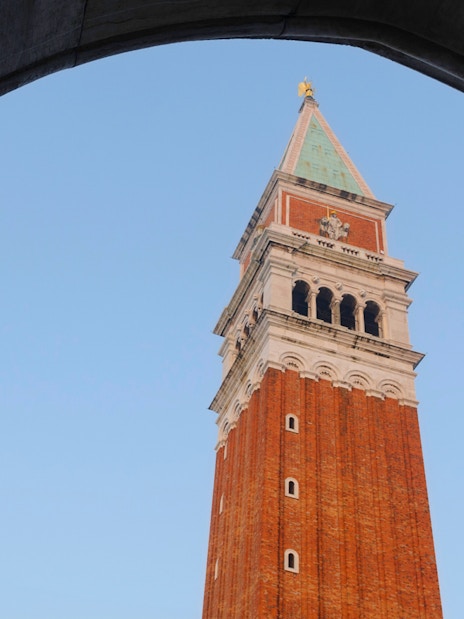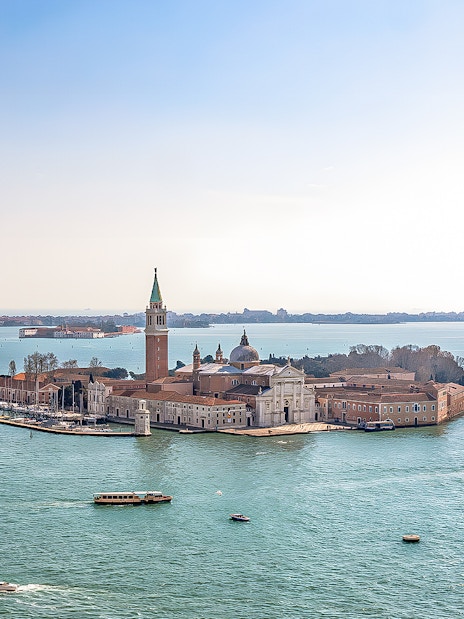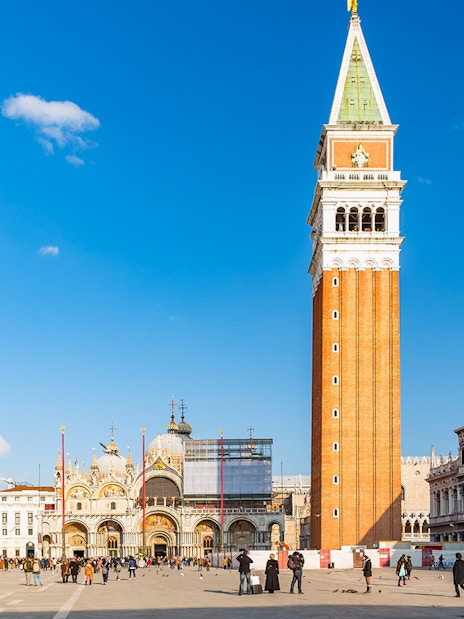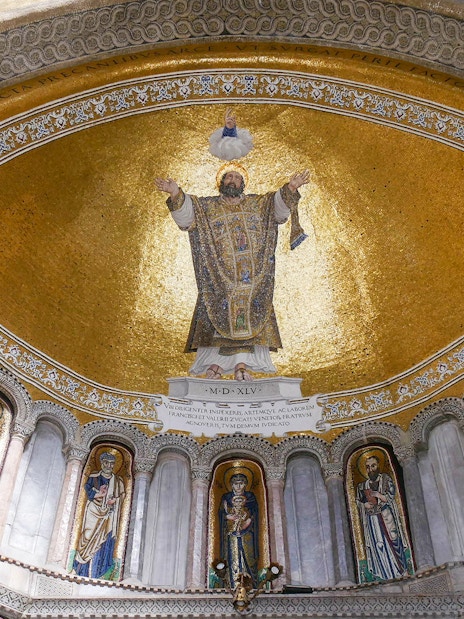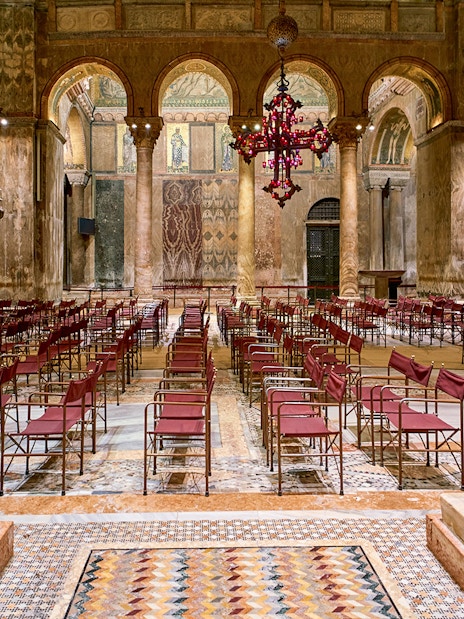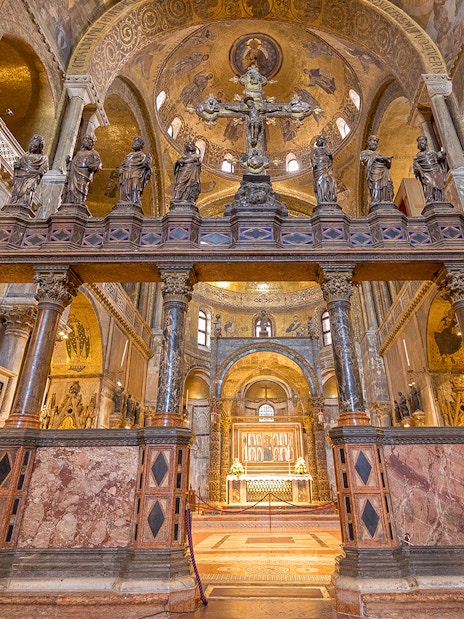St. Mark’s Campanile tickets

- Discover the tallest structure in Venice, the bell tower of St. Mark’s Basilica, standing 99 meters tall since the 16th century.
- Catch a glint of the golden Archangel Gabriel statue at the apex, and admire the statues of Roman gods as you explore the bronze and marble loggetta.
- Walk past the 5 great bells of St. Mark, which were once used to observe executions, political assemblies, or religious ceremonies.
- Enjoy sweeping views of St. Mark’s Square framed by the belfry arches from this tower that has stood the test of earthquakes, lightning strikes, and more.
- Discover the tallest structure in Venice, the bell tower of St. Mark’s Basilica, standing 99 meters tall since the 16th century.
- Catch a glint of the golden Archangel Gabriel statue at the apex, and admire the statues of Roman gods as you explore the bronze and marble loggetta.
- Walk past the 5 great bells of St. Mark, which were once used to observe executions, political assemblies, or religious ceremonies.
- Enjoy sweeping views of St. Mark’s Square framed by the belfry arches from this tower that has stood the test of earthquakes, lightning strikes, and more.
Inclusions
- Entry to St. Mark’s Bell Tower
- Tip: Notice the dents and scratches on the tower's largest bell, the Marangona. These are the marks of survival on the only bell that endured the tower's collapse.
- Facilities: Wheelchair Accessibility, Elevators.
- Strict Dress Code: Please wear clothing that covers the knees and shoulders.
- It is required for minors to be accompanied by an adult.
- These tickets can't be cancelled or rescheduled.
Spend less time waiting and more time exploring St. Mark’s Campanile & San Marco History Gallery!
- Breeze through the waiting queues at St. Mark’s Bell tower and enjoy quick elevator access to its 98-meter-high observation deck.
- Catch stunning views of Venice’s landmarks like St. Mark's Basilica and the Grand Canal from the city’s tallest structure.
- Don't miss out on the Logetta, a podium on the base of the bell tower, which features marble statues of figures from Greek mythology.
- Discover the fascinating secrets of Venice’s iconic gondolas at the San Marco History Gallery, with a real dissected gondola on display.
- Experience Venice’s past through an interactive VR journey that shows how Piazza San Marco looked centuries ago.
Spend less time waiting and more time exploring St. Mark’s Campanile & San Marco History Gallery!
- Breeze through the waiting queues at St. Mark’s Bell tower and enjoy quick elevator access to its 98-meter-high observation deck.
- Catch stunning views of Venice’s landmarks like St. Mark's Basilica and the Grand Canal from the city’s tallest structure.
- Don't miss out on the Logetta, a podium on the base of the bell tower, which features marble statues of figures from Greek mythology.
- Discover the fascinating secrets of Venice’s iconic gondolas at the San Marco History Gallery, with a real dissected gondola on display.
- Experience Venice’s past through an interactive VR journey that shows how Piazza San Marco looked centuries ago.
Inclusions
- Priority entry to St. Mark’s Bell Tower
- Priority entry to San Marco History Gallery
- Virtual reality experience at San Marco History Gallery
- English, Italian, French, Spanish or German-speaking host (as per option selected)
Exclusions
- Guided tour
- Tip: While the bell tower offers great views, take some time to observe the architecture, the golden wind vane, and the legendary winged lion perched on top.
- St. Mark's Campanile is wheelchair and pram/stroller accessible with an elevator to get to the top.
- You can cancel these tickets up to 24 hours before the experience begins and get a full refund.
Skip long queues to explore St. Mark's Basilica & the Bell Tower with the Venice Pass.
- Buy a Venice Pass and bypass long lines to visit the iconic St. Mark’s Basilica and the Bell Tower.
- The pass also gives you priority access to the elevator that will take you to the top of the Bell Tower, which offers gorgeous city views.
Skip long queues to explore St. Mark's Basilica & the Bell Tower with the Venice Pass.
- Buy a Venice Pass and bypass long lines to visit the iconic St. Mark’s Basilica and the Bell Tower.
- The pass also gives you priority access to the elevator that will take you to the top of the Bell Tower, which offers gorgeous city views.
Inclusions
- Skip-the-line entry to St. Mark’s Basilica
- Fast-track access to the elevator for the Bell Tower
Exclusions
- Local guide
- Hotel transfers and transportation
- Meals
- This is a self-guided tour.
- Your tickets guarantee skip-the-line entry but there might be a short wait at security.
- You can cancel these tickets up to 24 hours before the experience begins and get a full refund.
Combo (Save 5%): St. Mark’s Basilica + St. Mark’s Bell Tower Tickets
5% off
- This combo saves your money while giving you access to 2 must-see Venetian attractions – St. Mark’s Basilica and St. Mark's Bell Tower.
- Enjoy skip-the-line entry to St. Mark’s Basilica, one of the city's most visited landmarks known for its Byzantine architecture.
- Explore the 'Golden Church', famous for its dominant golden mosaics and stunning architecture.
- At the St. Mark's Bell Tower, explore all sections including the loggetta, adorned with statues of ancient Roman deities.
- Admire the 5 great bells of St. Mark in this 16th-century tower, the tallest building in Venice. Easily ascend by elevator!
- This combo saves your money while giving you access to 2 must-see Venetian attractions – St. Mark’s Basilica and St. Mark's Bell Tower.
- Enjoy skip-the-line entry to St. Mark’s Basilica, one of the city's most visited landmarks known for its Byzantine architecture.
- Explore the 'Golden Church', famous for its dominant golden mosaics and stunning architecture.
- At the St. Mark's Bell Tower, explore all sections including the loggetta, adorned with statues of ancient Roman deities.
- Admire the 5 great bells of St. Mark in this 16th-century tower, the tallest building in Venice. Easily ascend by elevator!
Inclusions
- Skip-the-line entry to St. Mark's Basilica
- Skip-the-line entry to St. Mark's Bell Tower
St. Mark’s Basilica
- Tip: Don't miss the opportunity to shop for souvenirs and Venetian crafts near St. Mark's Square. Visit the shops around Calle Larga XXII Marzo too.
- Strict dress code: All guests must wear clothing that covers their shoulders and knees to enter the basilica.
- Keep your camera tucked away – photography is strictly not allowed at the venue.
- This experience is wheelchair and pram/stroller accessible.
- A ramp is available at the Porta del Fiori (Door of Flowers) entrance on the left-hand side of the basilica.
- The Museum on the upper floor of the basilica is served by both a lift and stair lifts.
St. Mark’s Bell Tower
- Tip: Near the Bell Tower, find authentic local delicacies in the Castello or Cannaregio districts such as 'sarde in saor' or 'fegato alla veneziana'.
- Facilities: Wheelchair Accessibility, Elevators.
- Adults should compulsorily accompany minors.
- These tickets can't be cancelled or rescheduled.
Top things to do in Venice
Why visit St. Mark’s Campanile?

- Incredible views: St. Mark’s Campanile offers you a birds-eye view of Venice and the network of canals, lagoons and of course, unique architecture. On a clear day, you can even see the Alps in the distance!
- History meets astronomy: From an 11th century watchtower to a lighthouse, and now finally, a bell tower, it is loaded with history. It was also the site of Galileo Galilei's first publicly demonstrated the telescope in 1609.
- Popular photography spot: St. Mark's Campanile’s distinctive onion shape make it a popular place for photography and sightseeing. It also has St. Mark's Basilica and the Doge's Palace, in the background, which makes for great photographs.
Quick facts | St. Mark’s Campanile

- Location: P.za San Marco, 30124 Venezia VE, Italy
- Construction date: 12th century
- Architect: Unknown
- Height: 98.6 meters
- Materials used: Marbles and stones
- No. of steps: 323 steps
Plan your visit to St. Mark’s Campanile

What are the St. Mark’s Campanile opening hours?
Daily: 9:30am to 9:15pm.
Last admission: 15 minutes
Best time to visit: Get to St. Mark’s Campanile as soon as it opens, or late afternoon to avoid crowds. The low season, which starts from November to March, is an excellent time to visit for a peaceful visit.
Detailed St. Mark's Basilica hours
Where is the St. Mark’s Campanile Located?
Address: P.za San Marco, 30124 Venezia VE, Italy
St. Mark’s Campanile is located on Saint Mark's Square, near the Grand Canal.
Getting to St. Mark's BasilicaHighlights of St. Mark’s Campanile

View from the top
Thanks to its 98.6 meters (323 feet) height, St. Mark’s Campanile offers stunning views of Venice. You’ll see the surrounding lagoon with its ships, distant islands like Giudecca and San Giorgio Maggiore, and the nearby Piazza San Marco square. Visit in the spring for better views with clear skies.

Venetian Gothic architecture
The bell tower was inspired by Eastern and Western influences, characterized by elegant lancet arches, intricate tracery, and ornate stone carvings. Its top is capped by a pyramidal spire with a gold weathervane in the shape of an angel, serving as a symbol of the city's patron saint, St. Mark, at its peak.

Bells & Bellringers
Discover the distinctive bells of St. Mark’s Campanile, each serving a specific purpose. Marangona signals the start and end of the workday, Nona marks the ninth hour, Trottiera chimes during Piazza San Marco races, Mezza Terza sounds in the third hour, and Renghiera notifies city council meetings. The bell ringers have exceptional skill and perform at concerts for guests. It’s not as easy as you might think!

Spire
The spire is a distinctive feature of St. Mark's Campanile. It is a pyramidal structure made of brick and stone, covered with lead plates, and topped with a golden weathervane in the shape of an angel representing St. Mark. It is visible from several parts of Venice and serves as a beacon for visitors through the canals of Venice.

Logetta
Logetta is located at the base of St. Mark’s Campanile in Venice. Designed by Jacopo Sansovino in the 16th century, it served as the meeting place for the city’s leaders. The structure has intricate carvings and decorations, including statues and bas-reliefs depicting scenes from Venetian history. You’ll also find a marble staircase leading to the top of the Campanile.
Climbing the St. Mark's Campanile

Before the climb
- Purchase tickets online or at the tower's base in St. Mark's Square, with options for skip-the-line and bundle tickets available.
- Consider timing your visit around sunset for stunning views of Venice.
- Arrive 10-15 minutes before your reserved timeslot to ensure admission within 30 minutes.

The climb
- Choose between climbing 323 steps or taking the elevator to the top.
- The tower offers panoramic views of Venice, with an audio guide available for historical insights or a guided tour for a personalized experience.
- It was originally built as a lighthouse and is renowned for its connection to Galileo Galilei.

Reaching the top
- Upon arrival, head to the "skip-the-line" area and present your smartphone ticket to the staff.
- Download the audio guide app from the iOS or Android store for offline use during your climb.
- Capture beautiful photos and enjoy the breathtaking views of Venice, especially during sunset.
Frequently asked questions about St.Mark’s Campanile tickets
A ticket to the St. Mark’s Campanile typically ranges from €12 - €15 for adults. Children under six years old can enter for free. You can get a combo ticket with access to both the Campanile and the Basilica at €30.
Yes, tickets can be bought on the day of your visit, either online or at the tower's base in St. Mark’s Square.
You can buy tickets to St. Mark’s Campanile online as well as offline. Online tickets are the best option as you can book months in advance and get discounts and deals.
Yes. You need tickets to view the St. Mark’s Campanile. You must show your tickets at the entrance, while foreign nationals must also display their passport and visa details at the time of entry.
Yes, visitors can often purchase combined tickets that include access to both St. Mark's Campanile and St. Mark's Basilica, offering a comprehensive experience of these iconic landmarks in Venice.
Yes, there are skip-the-line options available for St. Mark’s Campanile tickets, allowing visitors to bypass the queues and access the tower more quickly.
Yes. You can go to the top of St. Mark’s Campanile. It offers amazing views of Venice and surrounding islands like Giudecca and San Giorgio Maggiore.
St. Mark's Campanile in Venice, Italy was designed by architect Giorgio Spavento in the 16th century.
St. Mark’s Campanile was built in the 12th century but was restored and reconstructed several times after.
Marbles and stones were used to build St. Mark’s Campanile.
St. Mark’s Campanile's bells serve a unique function and produce different sounds. There are five bells—Marangona, Nona, Trottiera, Mezza Terza, and Renghiera. Marangona is the largest bell rung at the beginning and end of the workday, Nona is rung to note the ninth hour of the day, and Trottiera when races are held in Piazza San Marco. Mezza Terza, the fourth bell, is hit during the third hour of the day, whereas Renghiera is rung to notify city council members of meetings.
Logetta is a small structure at the base of St. Mark’s Campanile. It was designed by Jacopo Sansovino in the 16th century and served as the meeting place for the city’s leaders.
St. Mark’s Campanile is 98.6 meters (323 feet) tall.
St. Mark’s Campanile is located on Saint Mark's Square, near St. Mark's Basilica and Grand Canal.
St Mark’s Campanile is open daily from 9:30am to 9:15pm. The tower is closed for entry 15 minutes before it closes for the day.
You can catch fantastic views of Venice, far off lagoon with its ships, distant islands like Giudecca and San Giorgio Maggiore, and the nearby Piazza San Marco square.
No. There are no restrictions on who can climb the St. Mark’s Campanile. There is also a lift for people who cannot climb.
Unfortunately, St. Mark’s Campanile is not accessible to people with disabilities. The entrance is narrow, while the steps to the top of the tower are steep.
Yes. Photography is allowed at St. Mark’s Campanile. However, avoid using flash and be careful when using your camera at the top of the bell tower.
More reads

St. Mark's Square

Tips







